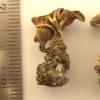
08-12-2025 21:04
Mark Stevens"Hello everyone,I'm relatively new to microscopy (

08-12-2025 18:59
 Lothar Krieglsteiner
Lothar Krieglsteiner
.. found by a seminar-participant, I do not know t

08-12-2025 17:37
 Lothar Krieglsteiner
Lothar Krieglsteiner
20.6.25, on branch of Abies infected and thickened

07-12-2025 16:07
Arnold BüschlenHallo, ich habe in einer Moos-Aufsammlung (epiphy

16-03-2014 22:00
Hello,I found this species a few months ago but ha

08-12-2025 13:39
Thomas Læssøehttps://svampe.databasen.org/observations/10572899

05-12-2025 17:33
 Bruno Coué
Bruno Coué
Bonjour, je serais heureux de recueillir votre avi
I collected some small caps of Helvella that are similar to H. acetabulum, but all of caps are small (I have some H. acetabulum specimens from there). Collected from south of Caucasia (Iranian part of Caucasus), a broadleaf forest.
Cap up to 1.5 cm broad, 1 cm high, upper surface brown, lower surface pale brown and pubescent, stipe ribbed with cream sharp edge ribs, up to 1.5 cm high and 0.7 cm diam (at base), white to cream.
Spores 16-19 x 11-12.5. what do you think about them?
?
I see in the photo that your specimen has rounded edge ribs, and Helvella acetabulum has sharp edge ribs. I think your specimen is more like Helvella costifera.
Best,
Fidel
the first idea observing the photo is H. costifera, also because the ribs are whitish until their very end.
It's true that, usually, H. costifera has more rounded rigde edges. But it should be said that the sharp ribs in H. acetabulum become evident when the ascomata are rather developed.
In our case, the very small ascomata and the spores at the lowest point of the usual range seem to indicate that the specimens are rather young. In the first stage the ribs are blunt and rounded also in H. acetabulum.
H. costifera, at least in my area of collection, is mostly gray rather than brown.
So I think we will keep some doubt about this collection.
Reza, what did you mean with "sharp edge ribs"? Because in your photo, as Fidel pointed out, the edges are rounded, not sharp. Maybe you mean that the ribs ends abruptly on the surface of the apothecium?
Regards
Mario

